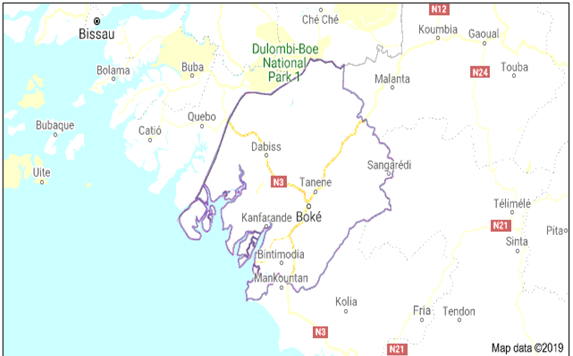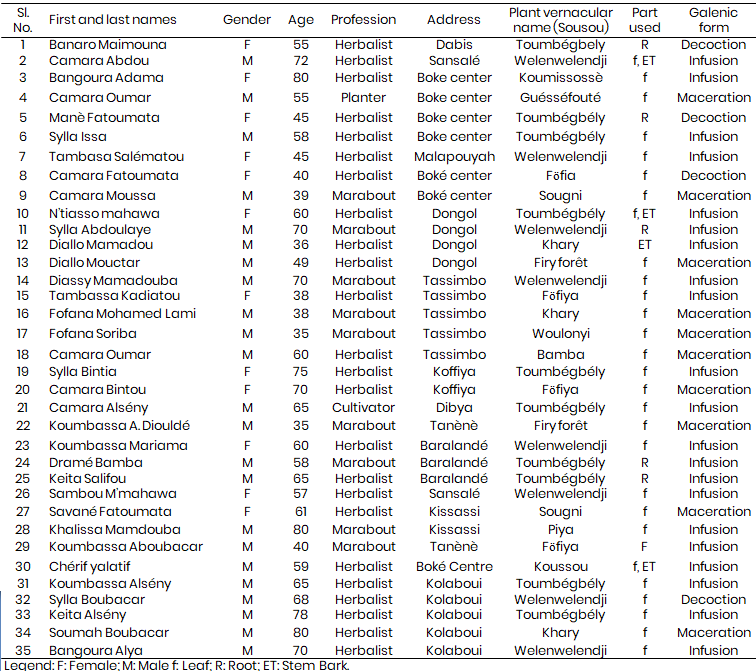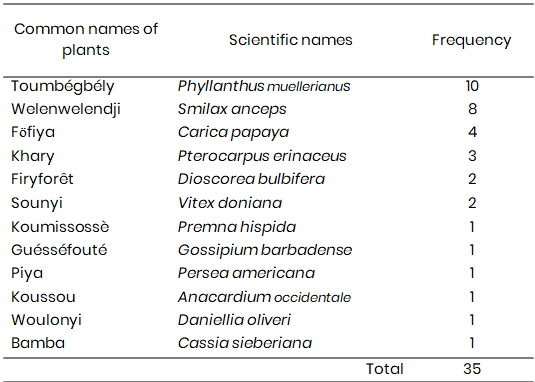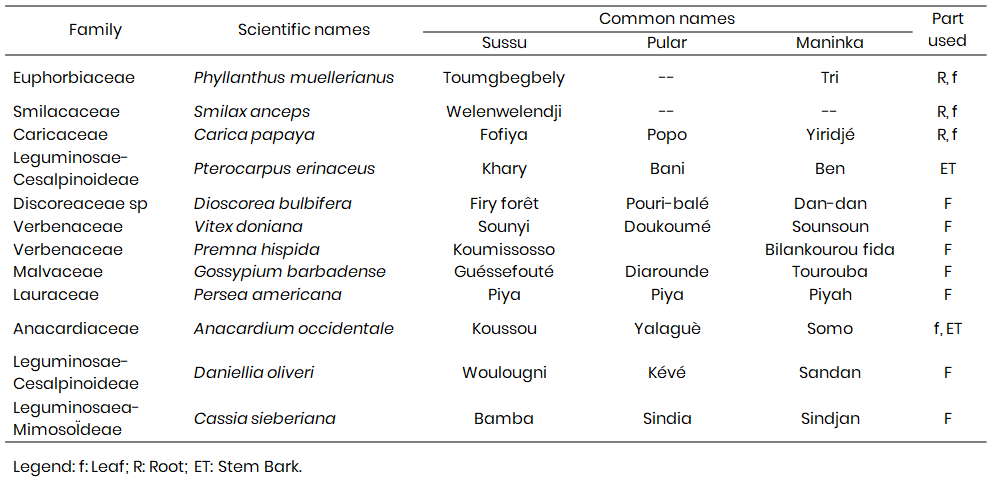Ethnobotanical investigation of plants used in the treatment of Prostatitis in the prefecture of Boke
Abstract
Within the framework of the valorization of medicinal plants traditionally used in the treatment of prostatitis in the prefecture of Boké, we carried out an ethnobotanical survey from April 06 to July 02, 2018. During this survey, we met 35 healers, mostly herbalists and marabouts, including 23 men and 12 women. These tradi therapeutes practiced a variety of activities, and for the most part had acquired their knowledge through family ties. The majority of these healers were elderly, aged between 55 and 70. The most frequently cited plants were Phyllanthus muellerianus (10 times), Smilax anceps (8 times) and Carica papaya (4 times). The mode of acquisition was through family ties (68.57%), followed by community and dreams (11.43%). Recipes were prepared mainly by infusion (60%) and maceration (28.57%). In view of these results, we feel it is imperative to extend this study to all prefectures and regions of Guinea, with a view to strengthening data banks in this field, for the benefit of future technologies for the pharmaceutical industry.
Introduction
The use of medicinal plants is still important in African traditions. Living beings have always sought to use plants to ensure their survival, and to derive remedies from them to treat their illnesses (Mahomoodally, 2013). Indeed, primary health care relies heavily on medicinal plants and the local knowledge associated with them (Fyhrquist, 2007). Ethnobotany, the science of how communities in a given region use plant species for food, clothing and medicine, plays a fundamental role in understanding how communities perceive, use and conserve plant resources (Aiyeloja and Bello, 2006; Betti, 2004). It enables popular know-how to be translated into scientific knowledge (Tahiri et al., 2012). However, in our tropics, most ethnobotanical studies in general and ethno-medicinal studies in particular, focus on the inventory and analysis of plant uses, without sufficiently highlighting the associated practices, which are thus overlooked (Malan and Neuba, 2011).
In Guinea, as elsewhere in Africa, traditional medicine is a very important component of cultural heritage, deeply rooted in the history, culture and beliefs of the people, and determines their aptitudes and behaviour in the face of the personal, family and social events of daily life (Banza et al., 2020). Until the middle of the 20th century, medicinal plants still held an important place in people's therapeutic arsenals, and there was no resistance to their use for both benign and serious illnesses (Banza et al., 2020).
In Africa, 80% of the population use medicinal plants to satisfy their health needs, either out of cultural habit or financial necessity (Banza et al., 2020). Some sexually-transmitted infections are bacterial in origin and can be cured by medicinal plants. It is therefore to be hoped that prostatitis can also be treated. By the age of 80, one man in nine (1/9) will have developed prostatitis (Krieger et al., 2008).
With this in mind, and faced with the high cost of conventional medicines and the risk of counterfeiting, more and more people are turning to herbal remedies. Traditional medicine is thus becoming a credible alternative worth exploring in depth.
We therefore decided to carry out an ethnobotanical survey in the Boké region, in order to identify a number of anti-prostatitis plants and, finally, to carry out a phytochemical studies of a number of species with prostatitis properties, hence the choice of the theme "Ethnobotanical investigation of plants with prostatitis properties in the Prefecture of Boke".
Material and Methods
Presentation of the study area
The prefecture of Boké was used for the ethno-botanical investigations. Located on Guinea's maritime coast, Boké covers an area of 334 km2. It is located in the North-Western part of Guinea, known as maritime Guinea, and more specifically in Baga country. The Boké region borders Senegal to the north, Guinea-Bissau to the west and the Gaoual prefecture to the northwest. To the south-west, the region borders the Atlantic Ocean (Fig. 1). It had a population of 108,145 in 2014, with a density of 35 inhabitants/km2. The natives who built Boké were initially Landoumas, after which the Bagas settled on the Boké plateau, extending as far as Guinea-Bissau to the north and approaching the plains of the Rio Kapatchez to the south.
Close to Guinea Bissau, a tarmac road allows you to cover the 250 km distance to Conakry quickly. At regional level, a tarred road takes you 50 km from Kamsar, and tracks lead to Sangarédi or Gaoual.
The town of Boké is the most cosmopolitan in Guinea, with Nalous living along the coast, Landoumas, Bagas, Soussous, Peuls, Kissis, Diakankés (Baralandés and Coréah) and Mikiforês. The "Camara" Fulani were the first from Fouta to settle in Kakandé (IRD, 2001).
Ethno-botanical survey
Study setting: The prefecture of Boké served the ethnobotanical investigation work, which took place from 06 April to 02 July 2018.
Working materials
Plant material: The plant material consisted of: leaves, roots and stem barks of the twelve (12) plants (Fig. 2 and Fig. 3) selected during the ethnobotanical survey. The different parts of these plants were collected from 06 April to 02 July 2018 in the prefecture of Boké. Botanical identification was carried out at the National Herbarium of Guinea.
Harvesting equipment: Daba, Cutters, Polyethylene bag, Cardboard folder; Scissors; Pruning shears.
Working method
Type and period of study: This was a prospective cross-sectional survey conducted from April 6 to July 2, 2018.
Study population: Our investigations focused on traditional practitioners in the prefecture of Boké recognized by the population in the treatment of prostatitis.
Method of analysis
The results are presented in tabular form, analyzed and interpreted. They were processed manually, and entered using computer software.
Inclusion and exclusion criteria:
Inclusion criteria
- Traditherapeutes living in Boké and recognized by the community, able to treat prostatitis
- Agree to participate voluntarily in the study.
Exclusion criteria
- Any healer also using modern prostatitis treatment.
Contact with the authorities
After receiving the mission order issued by the Department of Chemistry, we travelled to the prefecture of Boké to carry out the surveys. We then received orders from the prefectural and communal authorities.
Contact with healers
In the interests of maintaining confidentiality and safeguarding the family heritage, we had difficulty gaining access to information. Guided by an intermediary, we were able to meet the healers. This approach to our introduction to the healers involved the presentation of colas and sums of money, depending on the case.
Data collection
The data collection method used was interactive. It consisted in questioning healers about their art, in the form of an interview and on the basis of a survey form, a model of which can be found in the appendix.
In order to respect the confidentiality surrounding the practice of traditional medicine, we opted for individual contact, using the survey forms drawn up by the Institut de Recherche et de Développement des Plantes Médicinale et Halieutique. They contained the following information;
- Survey location;
- Information on the healer;
- Part of the plant used;
- Method of preparation;
- Dosage;
- Duration of treatment.
Drug harvesting
The drugs were harvested from plant parts such as leaves, roots and stem bark. The drugs were then transported to the city (to our home) and then to the organic chemistry laboratory of the Gamal Abdel University in Conakry for drying. This takes place in the shade, followed by packaging in polyethylene bags. At the end of this operation, the samples were transported to the Organic Chemistry Laboratory of the Chemistry Department at Conakry's Gamal Abdel Nasser University.
Healer's diagnosis
- Pain on urination;
- Pus on urination;
- Blood in urine;
- Lumbar pain.

Fig. 1: Boke Card
Results and Discussion
Our work focused on the ethnobotanical investigation and monograph of plants used in the treatment of prostatitis in traditional Guinean medicine in the prefecture of Boké, which took place from 06 April to 02 July 2018.
In total we met 35 healers including 23 men and 12 women. This predominance of men could be explained by the masculine nature of this disease. The majority of these healers were herbalists (68.57%), followed by marabouts (25.71%), planters (2.86%), and farmers (2.86%). The age of the traditherapeutes ranged from 35 to 80, with an average age of 60.
The most represented age group was 55 to 70 (45.71%) and the least represented was under 40 (22.85%) (Table 1). Judging by these results, the percentage of young people taking up the profession of traditherapeutes is low. This is why promoting traditional medicine must be a priority.
Of the 12 plants listed, Phyllanthus muellerianus (10 times), Smilax anceps (8 times), Carica papaya (4 times), Pterocarpus erinaceus' (3 times), Dioscorea bulbifera and Vitex doniana (2 times), and the other 6 only once (Table 2). Moreover, according to current literature, Pterocarpus erinaceus is of great importance in the treatment of a number of diseases.
It is used in North America and Europe to treat chronic diarrhoea. Decoctions or infusions of bark or roots are used to treat bronchial infections, toothache, painful menstruation, anaemia, post-partum haemorrhage, tapeworm infections, leprosy, wounds, tumours and ulcers; they are also used for their anti-emetic, purgative and tonic properties. Root-based preparations are administered as enemas to treat venereal diseases. A decoction of the leaves is used to treat fever and syphilis.
Carica papaya has many medicinal virtues. Phytotherapy uses the fruit, leaves, seeds, latex and roots. Depending on the part used, papaya is a purgative, an anti-inflammatory or an agent with positive effects on digestion, the treatment of sciatica caused by herniated discs; laxative; vermifuge; purgative; analgesic, relaxant; papaya protects against the induction of cotton cancer.
Papaya has a de-infiltrating and anti-inflammatory effect. Papaya is recommended for the treatment of peptic ulcer.
Infections from the leaves can be used to treat bloating and other digestive problems.
Table 1: Socio-professional distribution of healers

Table 2: Frequency of citing the plant

Cassia siberiana's purgative action can be attributed to its anthraquinones. Flavones promote diuresis and have antibacterial and anti-inflammatory activity. A test for antiviral activity against Herpes simplex virus type 1 (HSV-1) showed that Cassia sieberiana extracts had significant activity against this virus. In vitro tests showed only weak activity against trypanosomes. Leaf extracts were found to be active against Staphylococcus lutea, Mycobacterium phlei, Bacilllus subtilis and Proteus sp, (Kamanzi et al., 2002).The majority of these plants were prepared by infusion (60%), followed by maceration (28.57%) and decoction (11.43%) (Table 3).
Table 3: Breakdown of recipes by galenic form

With regard to the method of acquiring knowledge, our work shows that 68.57% of traditherapeutes acquired their knowledge through their families, respectively 22.86% (father), 20% (grandfather), 17.14% (grandmother) and 8.57% (mother).
The least common was acquisition through professional experience (2.86%) (Table 4).
Table 4: Different ways in which healers acquire knowledge

Inheritance was the most common method of acquisition, followed by community and dreams. This could be explained by the long African tradition according to which art is passed down from generation to generation (from grandfather to father or grandmother to mother).
The most commonly used parts are: leaves (60%); roots (31.43%), followed by stem bark (Table 5).
Table 5: Breakdown of recipes according to the part of the plant used

Twelve (12) plants were identified for the treatment of prostatitis. The most frequently cited plants belong to the Euphorbiaceae family (10); Smilaceae (8); Caricaceae (4); Leguminoseae-Cesalpinoideae (3) (Table 6).
Table 6: List of anti-prostatitis plants found in the prefecture of Boké

Fig. 2: Representative images of the plant species observed during the survey
Fig. 3: Representative images of the plant species observed during the survey
Conclusion
Today, with the help of scientific and technological progress, African countries must fight to bring the positive contributions of traditional medicine into the mainstream of modern medicine. In Guinea, Traditherapeutes are the first port of call for the treatment of urinary tract infections. Thus this botanical survey conducted from 06 April to 02 July 2018 in the prefecture of Boké identified 35 Traditherapeutes including 12 women and 23 men.
Botanically, 12 plant species were identified. The most frequently cited plant species were Phyllanthus muellerianus (10 times) and Smilax anceps (8 times). All the medicines were prepared with water, and the recipes were presented in different forms: Infusion 60%, Maceration 28.57%, and Decoction 11.43%.
The most frequently cited parts are root, leaf and stem bark. Our studies show that this knowledge is held almost exclusively by the elderly.
Conflicts of interests
Authors declare that there is no conflict of interest exists.
References
Aiyeloja, A. A., & Bello, O. A. (2006). Ethnobotanical potentials of common herbs in Nigeria: A case study of Enugu state. Educational Research and Review, 1(1), 16–22.
Banza, M. I., Kasanga, T. K., Mukakala, A. K., Ben N’dwala, Y. T., Ngoie, C. N., Cabala, V. D. P. K., Shutsha, N. T., Lire, L. I., Unen, E. W., & Kapessa, N. D. (2020). Prostatites aiguës sur prostate non tumorale aux cliniques universitaires de Lubumbashi: aspects épidémio-clinique et thérapeutique. The Pan African Medical Journal, 37, 290. doi:10.11604/pamj.2020.37.290.21260
Betti, J. L. (2004). An ethnobotanical study of medicinal plants among the Baka pygmies in the Dja biosphere reserve, Cameroon. African Study Monographs, 25, 1–27.
Fyhrquist, P. J. (2007). Traditional medicinal uses and biological activities of some plant extracts of African Combretum Loefl., Terminalia L., and Pteleopsis Engl. species (Combretaceae). Ph.D. Dissertation, University of Helsinki, Finland. (p. 185).
IRD. (2001). Info géographique de la Guinée Maritime. Conakry: Institut de Recherche pour le Développement.
Kamanzi Atindehou, K., Koné, M., Terreaux, C., Traore, D., Hostettmann, K., & Dosso, M. (2002). Evaluation of the antimicrobial potential of medicinal plants from the Ivory Coast. Phytotherapy Research, 16(5), 497–502. doi:10.1002/ptr.970
Krieger, J. N., Nyberg, L., & Nickel, J. C. (2008). NIH consensus definition and classification of prostatitis. JAMA, 282(3), 236–237. https://doi.org/10.1001/jama.282.3.236
Mahomoodally, M. F. (2013). Traditional medicines in Africa: An appraisal of ten potent African medicinal plants. Evidence-Based Complementary and Alternative Medicine, Article ID 617459. https://doi.org/10.1155/2013/617459
Malan, D. F., & Neuba, D. F. R. (2011). Traditional practices and medicinal plants use during pregnancy by Anyi-Ndenye women (Eastern Côte d’Ivoire). African Journal of Reproductive Health, 15(1), 85–93.
Tahiri, N., El Bouzidi, A., Zidane, L., Rochdi, A., & Douira, A. (2012). Étude floristique et ethnobotanique des plantes médicinales spontanées dans la région de Oulmes (Maroc). Journal of Forestry Faculty, 12(2), 192–208.
Copyright
Open Access This article is licensed under a Creative Commons Attribution 4.0 International License, which permits use, sharing, adaptation, distribution and reproduction in any medium or format, as long as you give appropriate credit to the original author(s) and the source, provide a link to the Creative Commons license, and indicate if changes were made. The images or other third party material in this article are included in the article’s Creative Commons license, unless indicated otherwise in a credit line to the material. If material is not included in the article’s Creative Commons license and your intended use is not permitted by statutory regulation or exceeds the permitted use, you will need to obtain permission directly from the copyright holder. To view a copy of this license, visit http://creativecommons.org/licenses/by/4.0/

